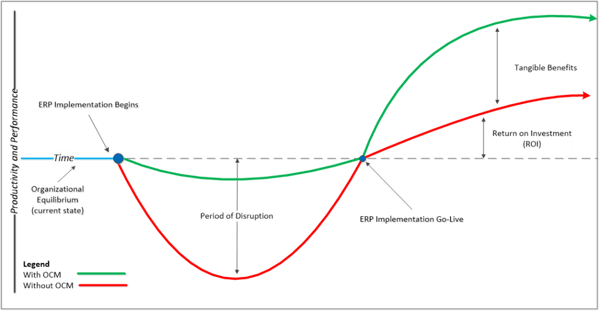The value of organizational change management (OCM) in ERP
ERP projects represent significant change for organizations. They are high risk, high-value initiatives, and often are scrutinized heavily. How well organizations prepare for the change and how it will impact the people, is a significant predictor of success. While ERP projects are often heavily supported by IT, ERP projects should be viewed as business investments and led by the functional workstreams.
ERP success criteria
Although ERP initiatives come in many forms (e.g. organizational-wide transformations, “BIG T”; selected adoption of new functionality within a business unit, “little t”; or a technology upgrade, “lift and shift”) success can be defined similarly:
- Meeting the objectives as outlined in the business case, charter, and/or statement of work
- Delivering the defined scope on time, within budget, and with an acceptable degree of quality resulting in minimal defects after cutover
- High levels of user adoption
- Sustained stakeholder satisfaction
The above success criteria are highly dependent on people, processes, and technology. To successfully manage the change associated with ERP projects the executive sponsor needs to be actively engaged and focus the people aspect by consistently embracing change, engaging the stakeholders impacted by the initiative, and creating a kaizen culture. Prosci®, the global leader in organizational change management best practice research, found that the number one success indicator of project success is an active and visible sponsor. Conversely, Prosci research shows that the number one indicator of project failure is the lack of active and visible sponsorship. Sponsors and leaders are extremely important during times of change. As described in The Progress Principle, the best leaders are able to build high performing teams who have great inner work lives. Author and American academic Teresa Amabile outlines how forward momentum in meaningful work-progress creates the best inner work lives for employees, described as having consistently positive emotions; strong motivation; and favorable perceptions of the organization, their work, and their colleagues.
According to a study by the Project Management Institute, Organizational Change Management continues to be a point of weakness for the majority of organizations. In their research, only 20 percent of organizations report their change management efforts are highly effective. The research also found that those with highly effective OCM practices “…are four times more likely to frequently use change management practices”, compared to those organizations with minimally effective change management practices. Prosci’s research shows that organizations that use a structured approach to managing the people side of change are six times more likely to achieve project results.
Tangible benefits
During times of change, there is always a dip in performance. This is a result of people unlearning the old way of working and learning the new way. Using effective organizational change management tactics won’t eliminate the performance dip, but it can minimize the dip and shorten the timeline to achieving the full ROI of the project.

Beyond effective project and requirements management, there are a number of ways organizations can improve and strengthen the value proposition and prevent those impacted most from being stuck in the “valley of despair” and minimize the period of disruption.
View the full story on ERPFocus.com.

